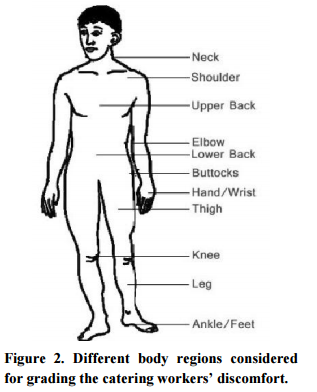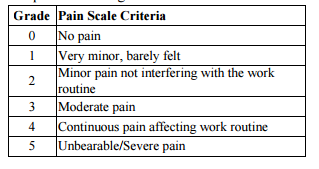IJCRR - 5(1), January, 2013
Pages: 100-105
Print Article
Download XML Download PDF
AN ERGONOMIC RISK ASSESSMENT FOR CATERING WORKERS
Author: M. Jagannath, Minal V. Shelat, D. Tamilselvi
Category: Healthcare
Abstract:Modern technological society is evolving with highly sophisticated equipments that persist in employing manual worker like Caterers. Catering workers are under increasing pressure to provide their services efficiently to the customers. This stressful situation can be made worse by their physical discomfort caused due to the increased exposure of repeated tasks and nature of the job. The objective of this study is to assess the physical discomforts of catering workers using Psychophysiological study. Twenty six participants involved in this study. The study was based on subjective measure by means of questionnaire using Rehabilitation Bioengineering Group Pain Scale (RBGPS). Results showed that there is a significant difference (p < 0.05) in pain scores of catering workers between the upper and lower body regions. Both men and women workers have significant discomfort in the lower back regions as compared to the upper back. Findings also showed that women workers have high physical discomforts in the regions such as neck, shoulder, upper back and lower extremities when compared to men. The outcome of this study helps the management and ergonomists to improve the workplace design, consequently enhance the quality of life of catering workers.
Keywords: Manual labour, Discomfort, Musculoskeletal disorders, Psychophysiological test.
Full Text:
INTRODUCTION
Modern technological society is evolving with automation and highly sophisticated equipments that persist in employing manual labour for majority of their activities in many industries and organizations [1]. Several explanations may be attributed to this approach being abundant manpower availability, cheap labour, flexibility in adjusting to demand requirements, etc. This necessitates the continuous assessment of the jobs involving manual work contents for ergonomic risk [2]. Hence, ergonomic assessment contributes an essential part in ergonomic interventions and in turn targeting on quality improvements of worker’s life. Ergonomic evaluation of manual operations among workers has been in vogue for more than a century. The discomfort or pain perceived on various regions of the human body by several types of manual work has been well-researched and documented [3, 4].
The cumulative trauma caused by the repetitive nature of work has attracted the attention of biomedical and ergonomics researchers all around the world [5]. When workers get overloaded due to physical or environmental causes, the efficiency of repeated jobs decreases and thus the quality of the services decreases likewise [6, 7]. Thus, ergonomic considerations require interventions to support manual labour in their working environment. Discomfort on workers lead to various types of disorders such as musculoskeletal disorders (MSDs), cumulative trauma disorders, etc. Literature suggests the existence of several risk assessment tools [8, 9].
In this paper, we used Rehabilitation Bioengineering Group Pain Scale (RBGPS) for evaluating catering workers discomfort and pain. RBGPS is a simple, low-cost tool based on existing methods and can aid organizations towards focusing on, and simultaneously improving the quality of working life.
METHODS AND MATERIALS Participants The study group consisted of 7 male and 19 female catering workers of our organization with a mean age of 34.8(±2.6) years and 42.1(±3.4) years respectively. Participants have minimum of five years of experience in the catering field. All participants were made fully aware of the experimental details, before their active involvement in this study. They signed the informed consent that conformed to the ethical guidelines of our organization.

Experimental Design Figure 1 shows the typical catering workers at work. Self administered questionnaire was given to each participant to grade their perceived discomfort or pain that occurs during their activities of job. Participants graded their discomfort at different body regions such as neck, shoulders, upper back, elbows, hands/wrists, lower back, hip/thighs, buttocks, knees, legs, ankles/foot, etc. The different body regions are shown in Figure 2. The pain score was categorized using RBGPS ranging from "No discomfort (0)" to "Severe pain (5)". The criterion for pain scale is depicted in Table 1.

Table 1. RBG pain scale criteria adapted from [8] that was used for evaluating perceived discomfort and pain of catering workers.

Statistical Analysis Skewness test performed on the discomfort/pain scores showed that they were not normally distributed. Hence a nonparametric test, MannWhitney U test was used to determine the significant difference in pain scores between the men and the women catering workers. Friedman test was performed for pain scores within participant, to determine the differences in discomfort among the different body regions. All statistical testing was carried out using commercially available statistical software (SPSSTM v10.0.1) at a significance level of p < 0.05.
RESULTS AND DISCUSSION Statistical tests were able to significantly differentiate (p < 0.05) the perceived discomforts in different body regions between men and women catering workers. The purpose of this study was to understand better the physical aspect of discomfort/pain among catering workers due to prolonged standing and nature of their jobs. The perception of discomfort/pain is a qualitative measure and is entirely subjective in nature. Psychophysiological tests involving questionnaire studies are well established methodologies for evaluating musculoskeletal related disorders.
The present study group consisted of men and women catering workers. Results from the questionnaire studies showed that the workers perceived pain in the upper extremities of the body in regions of shoulders, upper back, elbows and wrists. There is a significant (p < 0.05) perceived discomfort between men and women in the body regions of upper extremities, knees, legs, ankles. The women workers have significantly high discomfort as compared to men (Figure 3 and Figure 4).


A study by Pehkonen et al. [10] investigated a participatory ergonomic intervention process applied in 59 municipal kitchens. In groups of three to five kitchens, the workers participated in eight workshops, and evaluated solutions to optimize musculoskeletal load in their work. By the end, 402 changes were implemented as a result of minimizing the musculoskeletal load. Evaluative data were collected using research diaries, questionnaires, and inter personal interviews. The intervention model has shown the feasible and the participatory approach were mostly experienced as motivating factor. The changes in ergonomics were perceived to decrease physical load and improve musculoskeletal health [10]. In this study, we have attempted to understand the physical factors due to wide range of tasks performed by the catering workers.
The present study uses questionnaire in a potential analysis of work related musculoskeletal disorders. Heavy lifting, forceful and repeated actions are the causes of pain in back, neck, shoulders and joints. This study showed the clear evidence of discomfort and pain caused to the catering workers as a consequence of dynamic work situations. In the present study, the results showed that the perceived pain in the lower back region has significantly high when compared to the upper back regions. Both men and women catering workers have graded significantly (p < 0.05) high pain score in the lower back region. The reason may be due to their posture that they adopt during the course of food preparation. The buttocks region has the least significant pain score in both men and women catering workers. Stationary standing is a kind of posture adopted by the catering workers, in which they intermittently walk while they are on the job [9]. Several literatures had reported that stationary standing decreases the flow of blood to the muscles, accelerates the onset of discomfort or pain in the leg, back and neck muscles [11]. The present study corroborates with the findings of the literature.
Moreover, excessive standing may also cause the joints in the spine, hip, knees and feet to become temporarily immobilized or locked. This immobility can subsequently lead to rheumatic diseases due to degenerative damage to the tendons and ligaments [12]. To minimize the physical load of the catering workers, a flexible workplace design and ergonomic training should be given to the workers [13]. In addition, the catering workers expressed a wish for more support from the management and ergonomists to improve their quality of life.
CONCLUSION This study helps us to understand the consequences of work load in catering jobs. From the results, it is evident that there is a higher discomfort in the lower back region of catering workers when compared to the upper back region. There is a possibility that this high discomfort might aggravate their symptoms. Findings showed that there is a higher incidence of reported discomfort or pain in women workers who were employed in catering where there is a high level of exposure to physical loading as compared to men caterer. These inferences should be used while designing workplace and allocation of jobs based on the capability of the catering workers.
ACKNOWLEDGMENT: Authors would like to thank all the participants for their time and effort to make this study possible. Authors acknowledge the great help received from the scholars whose articles cited and included in references of this manuscript. The authors are also grateful to authors/ editors/ publishers of all those articles, journals and books from where the literature for this article has been reviewed and discussed. Authors are grateful to IJCRR editorial board members and IJCRR team of reviewers who have helped to bring quality to this manuscript.
References:
1. Diyar A, Ali MA, Kurt A. NEFCLASS based extraction of fuzzy rules and classification of risks of low back disorders. Expert Systems with Applications 2008; 35(4):2107-2112.
2. Changxu W, Yili L. Development and evaluation of an ergonomic software package for predicting multiple-task human performance and mental workload in humanmachine interface design and evaluation. Computers and Industrial Engineering 2009; 56(1):323-333.
3. Andersson GBJ. Epidemiologic aspects on low-back pain in industry. Spine 1981; 6(1):53–60.
4. Chaffin DB, Andersson BJG, Martin BJ. Occupational Biomechanics, 3rd Edition, New York: Wiley Interscience, 1999.
5. Wells R, Norman R, Neumann P, Andrews D, Frank J, Shannon H, Kerr M. Assessment of physical work load in epidemiologic studies: common measurement metrics for exposure assessment. Ergonomics 1997; 40(1):51–61.
6. Winkel J, Mathiassen SE. Assessment of physical workload in epidemiologic studies: concepts, issues and operational considerations. Ergonomics 1994; 37(6):979-988.
7. Choi G. A goal programming mixed-model line balancing for processing time and physical workload. Computers and Industrial Engineering 2009; 57(1):395-400.
8. Balasubramanian V, Swami Prasad G, Varadhan SKM. Quantitative evaluation of low back pain in bar benders. NICMAR Journal of Construction Management 2005; 20(4):31–36.
9. Balasubramanian V, Adalarasu K, Regulapati R. Comparing stationary standing with an intermittent walking posture during assembly operations. Human Factors and Ergonomics in Manufacturing 2008, 18(6): 666-677.
10. Pehkonen I, Takala EP, Ketola R, ViikariJuntura E, Leino-Arjas P, Hopsu L, Virtanen T, Haukka E, Holtari-Leino M, Nykyri E, Riihimäki H. Evaluation of a participatory ergonomic intervention process in kitchen work. Applied Ergonomics 2009; 40(1):115- 123.
11. Quiros L. BNL Ergonomics Bulletin, Brookhaven National Laboratory, New York, 2001, 4.
12. Bernard BP. Musculoskeletal Disorders and Workplace Factors: A Critical Review of Epidemiologic Evidence for Work-Related Musculoskeletal Disorders of the Neck, Upper Extremity, and Low Back. Department of Health and Human Services, Cincinnati, 1997.
13. Robertson MM, Huang YH, O’Neill MJ, Schleifer LM. Flexible workspace design and ergonomics training: Impacts on the psychosocial work environment, musculoskeletal health, and work effectiveness among knowledge workers. Applied Ergonomics 2008; 39(4):482-494.
|






 This work is licensed under a Creative Commons Attribution-NonCommercial 4.0 International License
This work is licensed under a Creative Commons Attribution-NonCommercial 4.0 International License